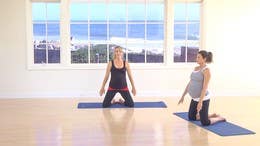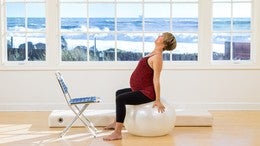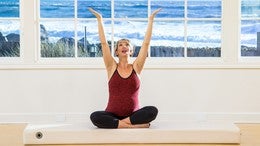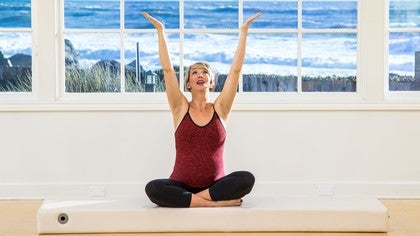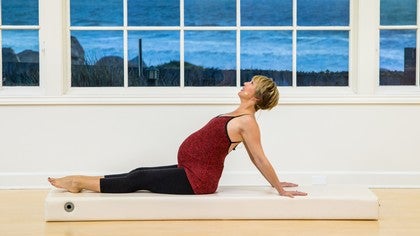Description
About This Video
Transcript
Read Full Transcript
Hi there. This is class and birth, three of our four part series about a [inaudible] birth. Um, and as I've said before, every class, but if you're joining me for the first time in this and you're kind of like, what is this class, what's going on? I want you to go back and watch the introduction to this whole series. This is a series specifically designed to bridge the gap between what you're learning in your prenatal Polonius classes and your postnatal plot is experience. And that gap there is what we, how we translate the work into our labor and birth experience. So that's the purpose of this four part series, the first two classes and the class number one I spoke about your body position options that you have during labor and birth class number two, I spoke a lot about different breathing techniques and some imagery and some ways to work with birthing partners and some of our calming, um, elements and I, that class is called calming and confidence. And now class three and then our class, our fourth class is going to be a little bit more movement based.
So if you're looking for some more movement and maybe a little bit more PyLadies class exercise class s you're going to find that a little bit more here but still not quite to the same um, capability that I'm doing, my prenatal PyLadies classes. So again, the intention here is a little bit different. So I just want to preface it with that. This class is called the mobility advantage and the reason I call it that is because being able to be mobile during your labor and birth. And what I mean by that is literally being able to move in and out of different positions, number one. Number two, by being mobile, like in your body, meaning being mobile, like having mobile joints and you know, having uh, muscles that can help you mobilize and all of those things is such a huge advantage during labor and birth. And you really can't emphasize that enough. I think in so many ways.
Mobility is kind of even takes precedent is a little bit over some of our strengthening and our endurance elements, although those are very important. Mobility is really such a huge advantage. So I want to show you some of your different options that you have. We can move through it together and like I've said in all of these classes, take what works for you and enjoy it and hopefully you can translate the into your labor or birth experience. So let's go ahead and dive straight in. So mobility not only helps us keep our muscles nice and soft, supple and our body and our bones able to respond into the event of labor and be able to open and all of those things I've been talking about over and over and over again. Mobility is what's going to help us achieve some of those goals.
Um, mobility also is a great way and some of the movements we do to stay connected not only to your own body, physically and mentally and emotionally, but also to kind of build that connection. Your baby that also is experiencing labor in a really intense way along with you. That baby is experiencing those contractions intensely. That baby is experiencing going through the birth canal really intensely and the baby is trying to work with your body and work with you to make their entrance, his or her entrance into the world. So in my opinion, mobility is really a tool to kind of help us keep that full connection of what's going on. So the first position we're going to be exploring it for mobility is lying side. Now I didn't talk about this position.
I'm in my first class about body position options for Labor, but it's true and sliding on your site is absolutely an option that you can have for labor or even for birth. Some women actually give birth lying on their side, um, but line on your side comfortably. And I found that um, you know, it can be a comfortable position to labor in to kind of to help feel comfortable. Um, it's a position that's really advantageous for prenatal practice because we're not lying on our back too long. It's comfortable, it's comfortable to breathe in. Suleiman side is a really nice position. I do have a class in one of my series where I do really have a lot of class lying on my side and can find that in my second series, which was filmed in 2013 and you can enjoy some of these exercises in there as well. So the first thing we're going to talk about is hip mobility. And we're going to do it first with some hip circles. So you're going to take your top leg and you're just going to really simply just circle your hip around. So you're just gonna be going forward, up, back and down, forward and back and down.
We're not going to be so strict here with how CBO, your pelvis stays or how stable your spine stays with this, focusing more on mobilizing that hip joint. So we really want to get that full range of motion in that hip joint. So this action of mobilizing your hip, it becomes really important because when we adopt some of our body positions, kneeling, squatting, sitting on the floor, sitting on a ball, hip mobility is going to be a key factor and getting into those positions comfortably. So we're going to start with some circles like that. The next one is internally rotating the hip joint. We certainly practice this in a lot of exercise, so internally rotating the hip joint, extending it out internally, rotating and back.
So I want this position to be just very free and I want you to take your fingertips and place them on that sits bone of your top hip and then want you to feel how the base of your pelvis or your sits bones widen as you internally rotate that hip joint and that internal rotation and that widening of your pelvis. It's going to become really important in your labor experience and we've speak about that a lot in class number one when we talk about our body position options. So we have that internal rotation, that extension and kind of practicing that. And then from here for hip mobility, holding your leg underneath your thigh, bringing your knee up to your shoulder, up to your chest and filling that beautiful stretch here and holding that. This is a great time for you to practice some of your breathing techniques. So breathing in and out.
Hum. Bringing your leg up to the site and you can keep your grasp here, or you can change your grasp up onto your knee and really deepening that hip joint and feeling that deep stretch. Let that thighbone really sink down into the pelvis. Feel that energy out through your sits bones. Really reach in the opposite direction and you may feel a deep stretch in your hip joint. You may feel a deep stretching your gluteal muscles and your buttocks and just whatever feels good for you to hear.
And they'll use that breath to soften the articulation that that joint try to fill. Your muscles aren't contracting, deepen that hip joint, but let them soften as you journey through your breath. Let the rest of your body soften. As we journey through your breaths. As I'm speaking to you, just use your breath here and relaxing. You should feel really nice in that hip joint. So from here we're going to go into some of our pelvic mobility. So this is some of my favorite stuff to do, lying side.
So I want you to draw the pelvis into a posterior tilt. So you're going to bring your pubic bone forward, you're going to contract your abdominal gently, and then I want you to bring your pelvis back. So you're reaching your tailbone back behind you. So you're just going forward and back and you're just feeling your spine react to it. You're even feeling your hip joints react to it. As you move that pelvis and you're feeling free, you're feeling how as when your pelvis is underneath you, everything is kind of closed and tight. And as you bring your pals behind you, everything opens and expands. Let's do that one more time.
It's a little bit more undulating here so you can kind of do your circle like that. I could also do my circle with a little bit of a lateral tilt. So here I'm lifting my hip up and I'm circling forward and around. So for me, and this, my pregnancy here at the end of the day when I'm very fatigued and I'm really, I'm late into my pregnancy, I have about, I'm about eight and a half months pregnant when I, at the end of the day I lay in bed and I do these hip circles and it really helps to kind of repair my body and my fatigue with that circulation increase into my pelvis and that breath. So you can see here my circle is from lifting my hip up, coming around and down. And then finally I just want you to do a little bit of lateral tilt of your pelvis here. So you're reaching up and reaching down.
She just pulling the pelvis up to the rib cage and then stretching out and just feel how that is. This is all of this is doing is moving those bones of your pelvis, creating that sense of mobility, that sense of freedom, and then go ahead and slowly bring yourself up. Great. So we're going to go ahead and go through the other side. So just so you can enjoy this, if you are doing this as a little bit of a movement class, you don't feel unbalanced in your body.
So you might be thinking like, okay Leah, this is all good and fine, but am I really going to be sitting here doing these exercises during labor? And My response is you sure? If you want to, that's totally up to you. Um, this might be something you find yourself laying on your side during maybe early labor and you find yourself just naturally wanting to do some of these hips circles and some of these pelvic tucks and tilts in circles of your pelvis. That's totally okay. That's what I mean by doing some of these PyLadies movements or these plebes inspired movements and during labor. So the I did, I did change direction and my circle, sorry I didn't mention it.
So from here we're going to do our internal rotation. So internally rotate, extend, bring it back. And then so something like this, you might not translate doing this exercise in your labor, but maybe you're doing more like your pelvis going forward and back and you're rotating your leg and maybe it looks more like that in your labor experience. Um, but the truth is, is if you do this prior to labor as a, as a preparation, maybe in that last month or so, you can really start to have your body will remember this, right? Your muscle memory will remember this and will certainly play a role in your labor experience. So now we go into some of those deep stretches. So bring your knee into your chest, find your relaxing breath here.
We kind of go forward and back. We'll do two more of those. And what this says too is we're not having to support our body in any way. Our entire body is supported by the mat or the bed or wherever relying. So now our circles are going to go a little bit more lateral. Um, and so it's a really nice position to feel really relaxed and um, especially if you're on a cushy surface, right? Like a bed, you can really let your body kind of relax and collapse into that surface.
And it's, it's just a really nice way to keep your body nice and mobile. And again, you can see how you gonna feel, how your pelvic bones, I'm going to do a lateral tilt. Your pelvic bones are just really shifting beautifully and naturally. And that's what we want here. So you can fill this nice, wonderful lateral tilt here. One more time.
So now we're going to sit forward in a sitting position. So now we want to look at our mobility of our spine. In this position, we're going to do our spine and our shoulder and our pelvis. Now they're all interlinked. They're all gonna work together. But we're going to change our intention a little bit about where the movement is initiated from or where it's, where it's being born from, which I used to be appropriate to talk about here. So our spine is, I want to start with forward and back. So what I'm doing is extension and flection. Now you can see, imagine if I had a string pulling me forward and back.
And that's exactly what I want. I want to feel kind of like a ragdoll. And that sounds something we talk about a lot in Peloton. But again, we're taking the exercises or taking on a different form and prenatals. So now from here, I want you to circle your tour. So now if you've had taken my prenatal classes, this is a huge thing. This is, this is like nothing new, right? I, I had done this in every class, right? But now we're kind of talking about where it comes in from Labor. And I've, you know, as I've told you, I've gone through two labors with [inaudible] being my guide is so to speak, and this movement that I'm doing right here was a big part of my like did it the whole time. Basically these circles were a big part.
Then I want you to do a lateral shift of your rib cage. So side to side here. So just filling that lateral ship. Now if you notice, and if you're correcting me, which I appreciate my posture and my alignment, I'm not super concerned about right now because that's not the point during labor. Now of course I'm not going to let everything go. I don't want to be uncomfortable. But you notice I'm not in this perfectly uniformed PyLadies worlds.
I'm not gonna be in that world when I'm in labor. I'm going to be in the movement world. I'm going to be in the breath world. So now from here I want you to come forward and back on a diagonal forward and back on a diagonal. So just a few times. So work through these exercises, experienced these exercises, and know that these are things that you're going to be able to use. If you hadn't taken all that time in your prenatal practice or even your before you were pregnant to understand spinal articulation, understand rib cage mobility, understand pelvic mobility. You would never get to this point where you can now let some of those formal rules aside and just move tunes way movement.
So moveability of the shoulders, we're going to roll forward and roll back. Now you probably are thinking like, why are we talking about the shoulders and the upper body? And it's, I'm going to do I have a reformer class here in this series or in this pregnancy that you're gonna really learn the importance of the upper body, but the upper body needs to stay soft and relaxed. It needs to be void of tension because as soon as we get tension up in our upper body has a profound effect on the tension that we hold in our pelvis and we want the opposite when we're going through labor and birth. So we went forward and back forward and back.
And this is just very natural. You can see how my spine is kind of responding to that. So now for our pelvis and our pelvic mobility with the spine, I was moving from this kind of place, maybe above my belly. Now I want to move from this place below my belly. So very basic. We have this forward and back. Now notice the difference there.
My spine responds, but my initiation and my intention is coming from my pelvis and that's a big difference here. So I want to move forward and back. And what this does too is it also increases mobility and that suppleness and that contraction and relax and stretch and open of the pelvic floor muscles as well as a great safe way to engage your abdominal muscles. So forward and back there. Another element of mobility that's really nice is to walk the pelvis laterally. So I'm basically doing like a lateral tilt and I'm letting my legs, my knees lift up as I go foe side to side, basically some Blaine's rocking side to side.
And so we're getting this kind of teeter totter of the pelvis and each time we lift that initial tuberosity, it's stretches out, opens up, expands that parent and the pelvic floor muscles, which is what we really want. And the last thing I want to do here for pelvic mobility is I like to do a little bit more of like a rotation element. So I'm going to rotate the right side of the pelvis back and bring it forward. Rotate the left side. So this is a really great deep stretch in the hip joint.
Deep stretch in the pelvic musculature. Cause as I rotate my femur slips back deeper into my hip twain, I get that nice stretch on the opposite side. I'm getting a stretch of the musculature that, that of the deep rotators of the musculature that attaches and pulls on the spinal muscles as well as I kind of pull that side of the pelvis forward. So I'm kinda moving back and forth this way and it's a really great way to engage and gain a little bit of mobility in that hip joint. So there are some of your options for spinal mobility, shoulder mobility, pelvic mobility. Now in a reclined position, I'm going to show you today with my hands supporting me, but you can certainly be leaning back on a ball against the wall or on a bed against some pillows. But I wanna do some hip mobility here.
So the first thing is as I want to just swing my legs side to side. So I find myself doing this at the end of the day too. Sometimes when I get in bed or sometimes upon waking in the morning, especially again at this late stage in pregnancy when I'm feeling a little bit stiff, feeling a little bit uncomfortable is I kind of just relax against my pillows in the bed and I'll just sway my hips side to side. So I'm getting the stretch in this rotation element of my hip joint here. So now to get a little bit more movement, um, we all know and love kind of like a butterfly action and this can be really helpful as well. So I'm getting, I'm getting that mobility of the hip joint and I can even start to bring in my pelvis and my spine here. And then to kind of grow on that, I can extend my legs and sweep them in, extend my legs and sweep them in.
So you can see how my entire body is responding to this and mobility and movement. Some allowing my spine to flex here as I go out. I'm lifting my sternum up and then as I bring it in and reaching and bring it in and it's very, it's very floppy here and I'm reversing my direction. It's very free. You can even see I'm letting my shoulders roll in and out. And that's what mobility is about. Millet, boom ability. It's really about being free and um, and just feeling open and feeling kind of calm and relaxed and that's what we want to go for.
So now we're going to move into kind of some of our kneeling positions as well and kind of show you what some mobility looks like there as well. So going into our kneeling position on all fours, again, you need to find the kneeling position that feels most comfortable for you. So if you're okay with your wrist flex like this, that's fine. Or if you need to go on your fist or if, um, you know, you need to put some, some towels or cushioning underneath you, that's going to be really helpful as well. And then like life, the body position, class class one that I showed you, you all those don't feel comfortable and you want to drape your upper body on a ball. You could probably do some of these exercises in there. It may be a little bit trickier, but it's certainly worth trying if that feels more comfortable for you.
So from here, I want you to start in as best of a safe kind of safe, um, you know, neutral position as you can. And we're gonna go for the spine mobility and we're going to go into a wave. So the wave curls up, it moves forward and it releases. So you're going to move through this wave position. And again, this would be a great tool to use during Labor for mobility of the spine and also mobility of the pelvis. But I'm initiating the movement from the spine. Now I want you to go the opposite direction so the wave arches up and then you curl into the flection there, the wave arches up.
So if you feel like you want your shoulders to get involved a little bit more, you're more than welcome to do that as well. You can fill a little circular motion of the shoulder. So there is some of your spinal mobility there in the form of a wave that goes in one direction and then goes in the other direction. Again, not emphasizing so much of the muscle contraction, but more of just the mobility and the movement of the spine that's happening. Then from we're going to sway side to side. Now this is a really great movement to do as well because it gets a little bit of a different action of the pelvis in response to the spine.
So I'm essentially just jetting my rib cage out to the side and letting my hips respond to it. And then going the other way. So that's a really nice one. And then that translates into circles. So I'm circling all the way around and I've done this in many of my classes so you can find it available to you. So it's so great prenatal exercise because it engages your abdominals, it gauges your pelvic floor and your shoulders. But as far as mobility of labor goes, it's very calming. It's very relaxing, it's very freeing and that's what we want during labor.
So we're going to have those kinds of those circle positions. And then finally I'm going to have you go down onto your elbows in this kind of modified updo or up stretch or a down dog position. So this is going to be really helpful for women. I'm kind of in those early mid stages of labor when we're thinking about opening up that pelvis. Um, maybe they want a little bit more support coming from their shoulders, a little less lever, a little less pressure on their wrists. This can be really helpful as well and you can kind of just copy some of those movements that we did when we were up on our hands, kind of getting some of that wave action going.
So mobilizing the spine through that wave can be really helpful and kind of some of the things that we want to go for. So I'm just reversed my wave here. I like to reach forward on a diagonal and come back on the diagonal. So just reaching forward. So again, kind of mobilizing a little bit different and circling around and going forward and back and forward and back. So that's going to be all great exercises for mobiling the spine mobilizing, mobilizing the spine in a kneeling position. So into the pelvis. We're going to briefly go through some of your options, which I know you know in love. So we have our, of course, our classic kind of cat stretch, um, where we really focused on our pelvic flection and extension, our lumbar fluxion, our lumbar extension rather, and pelvic posterior tilt and pelvic anterior tilt.
So those are going to be very helpful as well. Um, in this position, I also like to incorporate this kind of hindering forward and back. Now this mobilization is more of that focus on the issue of two bras to these or the sitz bones. So those two bones at the bottom, as you pull forward, you can fill them narrowing and as you pull back, you can feel them widening. You can actually hang out here a little bit in this position. You can feel that depending on your hip joint, you can feel that really nice opening of your systems here. So you get that Nice, wonderful stretch into the pelvic floor, that deep stretch.
So just forward and back there becomes really helpful as well. And then of course you can take that and even get a little bit more, if you're tight on one side, you can emphasize the diagonal. You can get a little bit deeper into a hip stretch here into your hip mobility here. So this may not look like you're mobilizing much in your pelvis, but you absolutely are. And some of those subtle movements that happen at the issue of tuberosity is in the pelvis. And then of course you're getting some increased mobilization in the hip joint as well here and for final little series here as we do a couple more here.
Coming back to center is we have our internal and external rotation of our femurs. So internally rotating and externally rotating. So as I do this, I'm going to flex my spine and I'm going to extend my spine. So I'm internally rotating so I'm allowing those sitz bones to open up as I'm flexing. And so a little contradictory here because as I flex my pelvis or I flex my spine and I post early tilt my pelvis facial tuberosity is actually close a little bit.
So we're kind of getting a little duality here and then I'm opposing that with this stretch here. But I'm going to start you there because I just want you to feel that kind of freedom in that movement. So one more time with the spine moving, now I want you to hold the spine still and do the same thing and see if you can fill a difference in how your pelvis responds to that internal and external rotation. One more time. Like this. And then I want you to add extension as you're internally rotating and you can fill, that is how you're going to get the most open position and then flex as you come in. So extend and flex one more time.
Extend and flex. So again, how you feel comfortable translating some of these exercises into labor. It's really going to depend on what stage of labor you, when you're in, how intense it feels for you and kind of how some of these exercises or some of these movement options may help you feel a little bit more comfortable in that, in that Labor experience. So we're going to move on to some of our ball exercises, kind of our last series here for our mobility advantage. Um, during labor and birth, it's going to be c sitting on the ball. And we talked about why this can be so great in our first class with some of our body position options. Um, so here again, a lot of this mobility movement is going to be repetitious. Um, and that's totally fine. Um, so you, you wanna sit on a ball that feels really comfortable.
You have that kind of that feedback, that tactile feedback from the ball. So the first thing we're going to do is we're going to start with circles. So I already told you earlier in the class that like circles of the pelvis and circles of the spine were re really big element for me in particular during both of my labors. So sitting here, um, if you feel comfortable enough to sit with your body upright, your hands on your knees, that certainly fine. If you're going to do this during the throws of labor, you're more likely going to find yourself with your arms on a bed or a chair or leaning forward on something. And as you're breathing through those contractions or you're resting in between the contractions, you're going to be doing more of your circles from there.
So from here coming up, we have kind of our lateral shifts of the pelvis. So again, repeating some of these movements that we've already explored, but just seeing how they feel different versus sitting on the floor or sitting on a mat or sitting on a bed on your bottom. And actually the experience of sitting up on a ball, so of the lateral shifts here. Then from here we're going to have the rotational elements where we rotate back and forth, rotate back and forth, and that's going to become really important as well. So we really want to explore all of these different ranges for our mobility before we go into labor. And then if you feel comfortable during Labor as well. And then from here I want to add some spinal movements so the legs are going to go forward, hands are going to be on the knees.
Now this one's a little bit more like, I always feel a little bit more like I'm doing like contemporary dance kind of thing here, but we already did the wave in the kneeling position, the four point million position, but you can repeat it here on the ball. So you're really just getting this wonderful articulation of the spine, this wonderful mobility of the spine, and you can see how I'm really just kind of letting my belly, I'm not hanging, it's not hanging out with pressure. I'm not pushing it out, but I'm certainly just letting it respond to the movement. Now I'm speaking, but if I weren't speaking, I know my mouth would be slightly open, my jaw would be relaxed. Now I can go the other direction. So not only am I getting spinal mobility here, but as you can see I'm getting hip mobility, I'm getting pelvic mobility, so I'm feeling a nice seep stretch through my pelvis and this may be an option that feels really good for somebody during their labor experience.
I'm in this flection position, so just like I did the circles, I also have experienced just this kind of action of swaying laterally through the spine and what kind of like a flex position or, or you're hinting forward and just kind of swaying back and forth in your body. And you can see that I'm shifting my weight from one side of my pelvis to the other. So I'm getting a little bit of mobility action in my pelvis. Now this is a little bit less common to see, but maybe I want to feel like I want to open up my body to get more breath or to just feel like I can breathe a little bit deeper. I might also want to do this kind of swing and more of a upright or even slightly extended position. So this could be really helpful.
And what comes to mind during Labor for something like this would be having your birth partner behind you sitting on the ball with you or sitting on a chair behind you. Again, arms up underneath you and you're relaxed back on their chest or on their shoulder and you guys are kind of swaying together. It looks like PyLadies. No, it doesn't look like [inaudible], but what it is is it's again, it's, it's that confidence in movement is stop confidence in that freedom and movement. It's that awareness of what your body needs. Joseph Pilati so knew what bodies needed when he created his work and he developed because when he was a young boy, he felt he knew what his body needed in order for it to feel the best given his circumstances and the situation. Then they went on to help people rehabilitate and then he went on to try to start this revolution about how people moved in their everyday life. So that's what's Palladia is about this. That's what's plot is about this.
It's goes much deeper than the set of exercises that he created. It goes into knowing what our body needs, using movement as a tool to facilitate what's best for our body. And that's exactly what we're doing here with the mobility advantage is that we have this key to this success during this experience for women of giving birth and mobility is one of the keys and one of the really important keys to that. So again, look at this as the perspective of what are those underlining things of plots that we're practicing? What are those covert qualities? What are those things that we can translate?
I'm not literally translate from the a hundred into labor, but the qualities and the attributes that we want to gain from those and how we translate that, and that's what I'm hoping to show you in this mobility class, is kind of how you can mobilize your body. And how when we did those short spines for all those sessions, then we couldn't do those shorts binds with our pregnant belly. So we started doing cat stretch more to now we're in labor and we're not necessarily doing the cat stretch, but we're still mobilizing that spine in the way that we started learning from the pelvic curl to the spine, the short spine in our regular platas classes, how that translates and how those benefits and all that dedication you had to practicing, that mobility comes into play during labor and birth. That's why I'm showing these exercises and they're simple, but they're really effective and I hope that you can use them in some way, shape, or form during your labor and birth experience. Thank you guys so much.
Prenatal Pilates: Pilates Birthing Series
Comments
 congratulations on your pregnancy. Your new series of classes is beautiful and it's just what I needed for my third trimester ladies. Thank you very much!
congratulations on your pregnancy. Your new series of classes is beautiful and it's just what I needed for my third trimester ladies. Thank you very much!

You need to be a subscriber to post a comment.
Please Log In or Create an Account to start your free trial.
